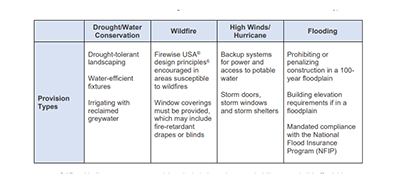
Freddie Mac: Approaches to Low-Income Housing Climate Resiliency Vary

As the number of weather-related disasters increases, states have implemented a range of requirements and incentives to mitigate their impact on federal Low-Income Housing Tax Credit properties, reported Freddie Mac, McLean, Va.
In a report, Climate Resiliency Incentives in LIHTC Qualified Allocation Plans, Freddie Mac said 32 states and Washington, D.C. have enacted measures aimed at protecting affordable housing properties from disasters and 27 states have provisions that aid recovery. The report said 17 states have provisions in both categories and nine states have neither.
The measures, found in LIHTC Qualified Allocation Plans, run the gamut from flood plain proximity requirements to fire retardant window coverings and set asides for disaster recovery.

“Developing and rehabilitating affordable properties with resiliency in mind is important to mitigating disaster risk that can displace families,” said Corey Aber, vice president of Mission, Policy & Strategy for Freddie Mac Multifamily. “Our research shows the varying approaches states are taking to make affordable housing more resilient and quick to recover.”
Aber noted the report highlights several property-level measures that may help multifamily properties mitigate disaster risk and improve recovery.
When allocating federal LIHTC, states have broad authority to set requirements, priorities and criteria, including those related to disaster resiliency and recovery, through their Qualified Allocation Plans. These plans have a substantial impact on affordable housing development in each state, because LIHTC is the most popular vehicle for funding affordable multifamily housing nationwide. The LIHTC program provides multifamily property owners that restrict rents and incomes with dollar-for-dollar reductions in federal taxes via tax credits. The new research builds upon a report Freddie Mac issued last year, Resiliency Efforts in Affordable Multifamily Housing, which examined the various public and private programs and initiatives designed to improve affordable housing resiliency.
